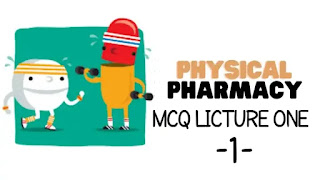مادة الفيزياء physical pharmacy ، هي احد المواد المهمة في كلية الصيدلة. اليوم نقدم لكم اهم mcq للفيزياء الصيدلانية المحاضرة الاولى.
تعد الفيزياء الصيدلانية للمرحلة الثانية مجالًا مهمًا في دراسة الصيدلة، حيث تركز على العمليات الفيزيائية والكيميائية المتعلقة بالأدوية وتأثيرها على الجسم. يشتمل هذا المجال على مجموعة متنوعة من المفاهيم والأسئلة التي يجب على الطلاب تفهمها لضمان نجاحهم في مجال الصيدلة. سنلقي نظرة على بعض الأسئلة المشتركة والمهمة في الفيزياء الصيدلانية للمرحلة الثانية.
نوفر لكم 40 سؤال mcq متعدد الخيارات حول مادة الفيزياء الصيدلانية. شاملة لجميع المادة الخاصة بالمحاضرة الاولى ، والتي تتحدث عن الذوبانية SOLUBILITY.
المحاضرة الأولى هي جزء من chapter 1 في المصدر الخاص بالفيزياء. لذا يمكن اعتماد باقي الجامعات عليها ، ويمكنكم حل الاسئلة.
الاسئلة التالية هيه نصاً من جامعة العين - كلية الصيدلة المرحلة الثانية. حسب المنهج المقرر والخاص بالذوبانية يمكن للجميع اعتمادها.
SOLUBILITY
Solubility in quantitative terms as the concentration of solute in
a. A sub-saturated solution at a certain temperature
b. A saturated solution at a certain temperature
c. A saturated solution at low temperature
d. A saturated solution at high temperature
Solubility in a qualitative way, the spontaneous interaction of two or more substances to form
a. A homogeneous molecular dispersion
b. A heterogeneous molecular dispersion
c. Complexation
d. None of the above
Solubility is an intrinsic material property that can be altered only by
a. Vaporization
b. Decomposition
c. Physical modification of the molecule
d. modification of the molecule
The solubility of a compound depends on
a. Chemical properties only of the solute and the solvent
b. Physical properties only of the solute and the solvent
c. Physical and chemical properties of the solute and the solvent
d. Physical and chemical properties of the solute only
Solubility, the phenomenon of dissolution of solute in solvent to give
a. A homogeneous system
b. A heterogeneous system
c. A mixture
d. An equilibrium system
Any drug to be absorbed must be present in
a. The form of colloidal at the site of absorption
b. The form of solute at the site of absorption
c. The form of solvent at the site of absorption
d. The form of solution at the site of absorption
Various techniques are used for the enhancement of the solubility of poorly soluble drugs like
a. Particle size reduction, crystal engineering
b. Salt formation, solid dispersion
c. Use of surfactant, complexation
d. All of the above
The selection of solubility improving method depends on
a. Drug property
b. Site of absorption
c. Required dosage form characteristics
d. All of the above
A saturated solution is one in which
a. The solute in solution is in equilibrium with the solid phase
b. The solvent in solution is in equilibrium with the solid phase
c. The solute in solution is in equilibrium with the liquid phase
d. The solute in solution is in equilibrium with the gas phase
An unsaturated or sub-saturated solution is one containing the dissolved solute in a concentration below that necessary for
a. Partial saturation at a definite temperature
b. Complete saturation at a definite temperature
c. Complete saturation at low temperature
d. Complete saturation at high temperature
The intermolecular forces that determine thermodynamic solubility
A . Solvent and solute are segregated
B . To move a solute molecule into solution
C . Once the solute molecule is surrounded by solvent
D . all of above
structural effects in solubility that lead to mutual interactions between
A . solute and the solvent
B . solvent and solvent
C . solute and solute
D . none of above
Solubility is quantitatively expressed in terms of
A . molarity
B . normality
C . percentage
D . all of above
dipole moments alone
A . is not adequate to explain the solubility of nonpolar substances in water
B . is adequate to explain the solubility of polar substances in water
C . is not adequate to explain the solubility of polar substances in water
D . is not adequate to explain the solubility of semi polar substances in water
As the length of a nonpolar chain of an aliphatic alcohol increases
A . the solubility of the compound in water don’t change
B . the solubility of the compound in water decreases
C . the solubility of the compound in water increases
D . none of above
Straight-chain monohydroxy alcohols with more than four or five carbons
A . cannot enter into the hydrogen-bonded structure of water and hence are only very soluble
B . can enter into the hydrogen-bonded structure of water and hence are only slightly soluble
C . cannot enter into the hydrogen-bonded structure of water and hence are only slightly soluble
D . cannot enter into the hydrogen-bonded structure of water and hence are only freely soluble
additional polar groups are present in the molecule
A . water solubility less decreases
B . water solubility less increases
C . water solubility decreases greatly
D . water solubility increases greatly
Branching of the carbon chain
A . reduces the nonpolar effect and leads to increased water solubility
B . increase the nonpolar effect and leads to increased water solubility
C . reduces the nonpolar effect and leads to decreased water solubility
D . don’t change water solubility
Nonpolar solvents are unable to reduce the attraction between the ions of strong and weak electrolytes
A . because of the solvent's high dielectric constants
B . because of the solvent's high temperature
C . because of the solvent's low dielectric constants
D . because of the solvent's low temperature
ionic and polar solutes are
A . not soluble or are only slightly soluble in polar solvents
B . not soluble or are only freely soluble in nonpolar solvents
C . soluble or are only slightly soluble in nonpolar solvents
D . not soluble or are only slightly soluble in nonpolar solvents
Nonpolar compounds, however, can dissolve nonpolar solutes with
A . similar internal pressures through induced dipole interactions
B . different internal pressures through induced dipole interactions
C . similar internal pressures through cohesive forces
D . similar internal pressures through adhesive forces
solute molecules are kept in solution by
A . the cohesive forces
B . the weak van der Waals– London type of forces
C . the weak hydrogen bonding
D . the adhesive forces
oils and fats dissolve in
A . carbon tetrachloride
B . benzene
C . mineral oil
D . all of above
Alkaloidal bases and fatty acids also dissolve in
A . nonpolar solvents
B . polar solvents
C . water
D . semi polar solvent
semipolar compounds can act as
A . nonpolar solvents to bring about miscibility of polar and nonpolar liquids
B . polar solvents to bring about miscibility of polar and nonpolar liquids
C . intermediate solvents to bring about miscibility of polar and nonpolar liquids
D . none of above
acetone is
A . increases partially the solubility of ether in water
B . decreases the solubility of ether in water
C . increases partially the solubility of ether in water
D . increases the solubility of ether in water
Propylene glycol has been shown to
A . increase the mutual solubility of acetone and peppermint oil and of water and benzyl benzoate
B . decrease the mutual solubility of water and peppermint oil and of water and benzyl benzoate
C . increase the mutual solubility of water and peppermint oil and of water and benzyl benzoate
D . increase the mutual solubility of water and peppermint oil and of acetone and benzyl benzoate
Propylparaben is
A . Very poorly soluble in water
B . Highly soluble in water
C . soluble in both water as well as organic solvents
D . partially soluble in organic solvent
Freely soluble (FS)
A . From 1 to 10 Parts of Solvent Required for One Part of Solute
B . From 10 to 30 Parts of Solvent Required for One Part of Solute
C . From 30 to 100 Parts of Solvent Required for One Part of Solute
D . From 100 to 1000 Parts of Solvent Required for One Part of Solute
Sparingly soluble (SPS)
A . From 1 to 10 Parts of Solvent Required for One Part of Solute
B . From 10 to 30 Parts of Solvent Required for One Part of Solute
C . From 30 to 100 Parts of Solvent Required for One Part of Solute
D . From 100 to 1000 Parts of Solvent Required for One Part of Solute
Slightly soluble (SS)
A . From 1 to 10 Parts of Solvent Required for One Part of Solute
B . From 10 to 30 Parts of Solvent Required for One Part of Solute
C . From 30 to 100 Parts of Solvent Required for One Part of Solute
D . From 100 to 1000 Parts of Solvent Required for One Part of Solute
Very slightly soluble (VSS)
A . From 1000 to 10000 Parts of Solvent Required for One Part of Solute
B . From 10 to 30 Parts of Solvent Required for One Part of Solute
C . From 30 to 100 Parts of Solvent Required for One Part of Solute
D . From 100 to 1000 Parts of Solvent Required for One Part of Solute
The component present in solution in small quantity is known as
A . Solvent
B . Solution
C . Solute
D . Liquid
The dielectric constant of water is
A . 20
B . 5
C . 50
D . 80
A supersaturated solution is one that contains more of the dissolved solute than it would normally contain at:
a. High temperature, were the undissolved solute present
b. Low temperature, were the undissolved solute present
c. A definite temperature, were the undissolved solute present
d. Moderate temperature, were the undissolved solute present



تعليقات
إرسال تعليق